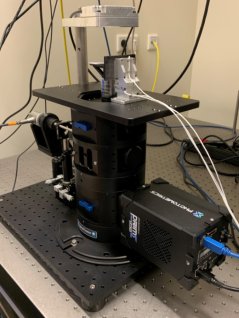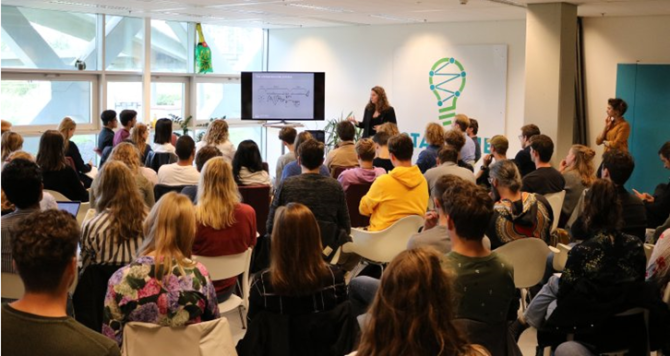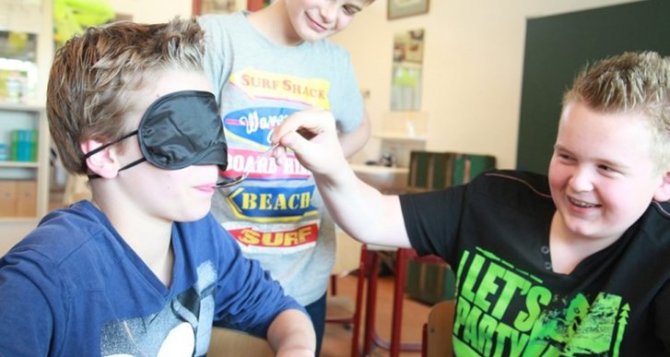
News
WUR + Partners = Science to Benefit Society
Regardless of how innovative the research at your university or research institute is, it will only benefit society if the discoveries are actually used. Wageningen University & Research calls this value creation, and it forms an essential part of the Strategic Plan Finding Answers Together. “It is important to gain knowledge about sugars, fibres, and vitamins in the lab, but you will only have impact when a company applies your knowledge and your innovative food items are put on the shelves of the supermarket and on the dinner table.”
At the Biophysics chair group, researchers have been working for five years on an ultra-precise and sensitive microscopy technique that zooms in on molecules so accurately that individual proteins become visible and emit light in different colours. The researchers are not simply doing this for fun. Agrotechnology researcher Niels Zijlstra: “We want our technology to be used in practice, this includes hospitals, pharmaceutical companies, food producers, and certainly at other universities and research institutes as well.”
We hope that our ultra-accurate microscope will benefit society.

What use does the Wageningen microscopy technique for major players in the field? Johannes Hohlbein – associate professor of Biophysics: “When you’re testing medication, you want to observe the effect at the cellular level. One cell contains many different proteins that can be affected by a medicine. The proteins light up in different colours under the microscope, but the cameras in the current microscopes — regardless of their quality or cost — are not able to display more than one shade of red, green, or blue at a time.” The new WUR technique uses a special glass slide that is located right in front of the camera and it pulls the colours apart, so to speak. Zijlstra, who is focused on the commercial side of the invention: “Our objective is that we can view nine different colours and thus proteins at the same time on one camera: three shades of red, three shades of green, and three shades of blue. That is a real breakthrough.”
Furthermore, the technique not only benefits the healthcare sector, but also the food industry. Hohlbein: “Large producers of meat substitutes use increasing amounts of different proteins to make their products resemble real meat.”
Innovation Grants
Hohlbein and Zijlstra are a good example of talented researchers who want to generate social impact with their invention, in the opinion of Gerlinde van Vilsteren, value creation project leader at WUR. In the Strategic Plan Finding Answers Together, Van Vilsteren is responsible for the sixth pillar entitled “meer ondernemerscultuur en -praktijk” (increased entrepreneurial culture and practice). In short, students and researchers must focus more on the actual use of their discoveries and talk to parties outside of WUR that can implement them in practice. WUR has to foster the conditions for the researchers to succeed. In this context, Hohlbein and Zijlstra received the Road to Innovation Grant from WUR last year. This new grant with a maximum amount of €50,000 — which has been awarded four times so far — should help the researchers on their entrepreneurial journey. Hohlbein: “The grant has given us the time and manpower — particularly through the appointment of Niels — to take the first entrepreneurial steps. This includes a patent application and obtaining a substantial NWO grant.”
Entrepreneurship Is More Than Just Starting a Business
Van Vilsteren says that increasing entrepreneurship can be achieved in different ways. “As WUR student or researcher, you do not always need to start your own business. First and foremost, entrepreneurship means that you are thinking about society’s needs and how your knowledge can provide a solution. As WUR, we want to bring about structural changes in society in areas such as agriculture, nature, and sustainability, and this is achieved together with partners in and outside of the academic environment. After all, that is Finding Answers Together.”
Entrepreneurship is also the development of social tools such as Smaaklessen
Van Vilsteren provides some other examples of entrepreneurship: “It ranges from Wageningen knowledge that is being incorporated in laws and regulations by the Ministry of Agriculture, Nature and Food Quality (LNV) to the Smaaklessen (tasting lessons) for primary schools that were developed by WUR in a collaboration with the Voedingscentrum (nutrition centre). It also includes the public websites that WUR has launched over the past years, such as tekenradar.nl in a collaboration with the RIVM. This is how knowledge is transformed into tools that are accessible for society.”

WUR Must Embrace Entrepreneurship
To achieve pillar six, “meer ondernemerscultuur en -praktijk” (increased entrepreneurial culture and practice), by the end of the term of the Strategic Plan, a lot more has to happen than merely setting up a grant such as the Road to Innovation Grant. The entrepreneurial spirit must be embraced within the organisation: “This is not equally self-explanatory for everyone at WUR. Some of the students are unsure about the collaboration with the business community, because they think that academics should not have any contact with commercial parties. We try to explain to them that independence comes before everything, but that opportunities arise when you start talking to businesses. Although it is important to gain knowledge about sugars, fibres, and vitamins in the lab, you will only have real impact when a company applies your knowledge and your innovative food items are put on the shelves of the supermarket and on the dinner table, meaning that it also contributes to sustainability and a healthy diet.”
Value creation is in the Wageningen DNA: we know that others must eventually apply the knowledge.
Van Vilsteren feels that there are numerous Wageningen examples of entrepreneurship that can inspire our students and employees. “This includes Noldus, a business that is now a global provider of software for analysing human and animal behaviour: it started with the research by WUR PhD candidate Lucas Noldus about modelling the behaviour of fruit flies.”
Value Creation in Education
However, only providing inspiration is not enough, in Van Vilsteren’s opinion. “Entrepreneurship is a quality that can be taught and that must be embedded in education from the first day at the university. This not only includes faculty participation in student challenges or programmes by StartHub, but also through the implementation of continuous learning tracks in which entrepreneurial skills are taught in the context of the degree programme.

Van Vilsteren suggests that, with a research arm that is fully focused on applied research, WUR is already strongly focused on value creation compared to other universities. “But this is not a reason to sit back and relax. Value creation is an increasingly important condition for receiving research funding from the ministries and the EU. But this is not the primary reason for our aspirations. At WUR, we know that others must eventually apply the knowledge. Even fundamental research is aimed at realising breakthroughs that bring Sustainable Development Goals, such as increased food security, closer to fruition. And in all cases we are looking for collaboration within WUR and outside of it with national/international partners and universities. Value creation is in the Wageningen DNA.”
Win-win situation
For Johannes Hohlbein and Niels Zijlstra, entrepreneurship and value creation are the next logical steps for their invention. “After five years of research, we do not want anything more than for our technology — and ideally a whole new microscope that incorporates the technology — to go to market. We know that our products are very interesting commercially.” The researchers also want their invention to become available to as many people as possible. “We are trying to benefit society. At the moment conventional microscopes cost between the €500,000 and €1 million each, which means relatively few people have access to one at their organisation or company. We strive for a price of €150,000 per microscope, and it has the added benefit of displaying a lot more colours for protein molecules. It is a win-win situation.”